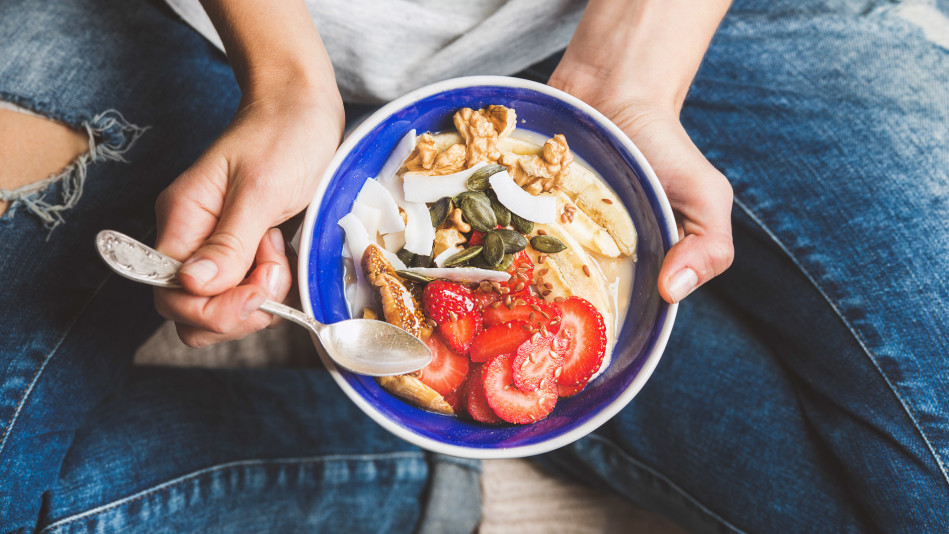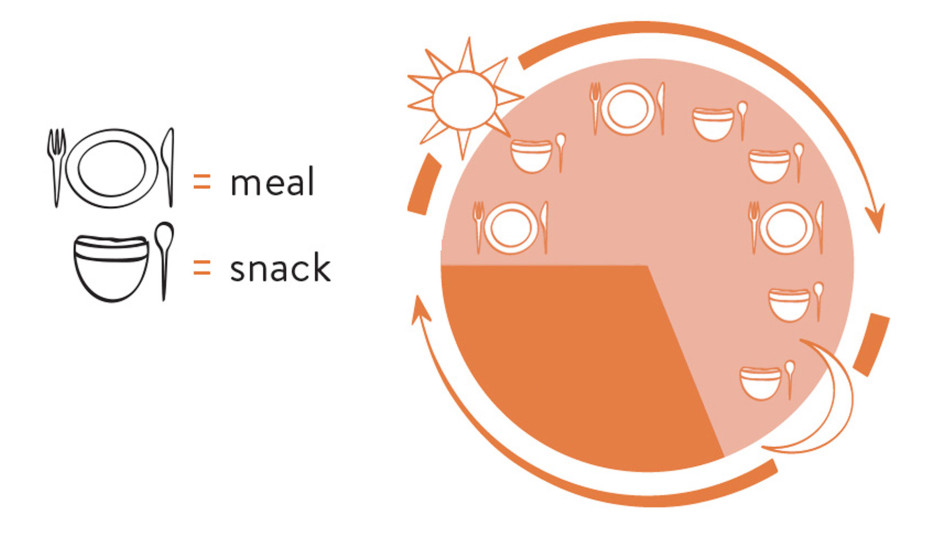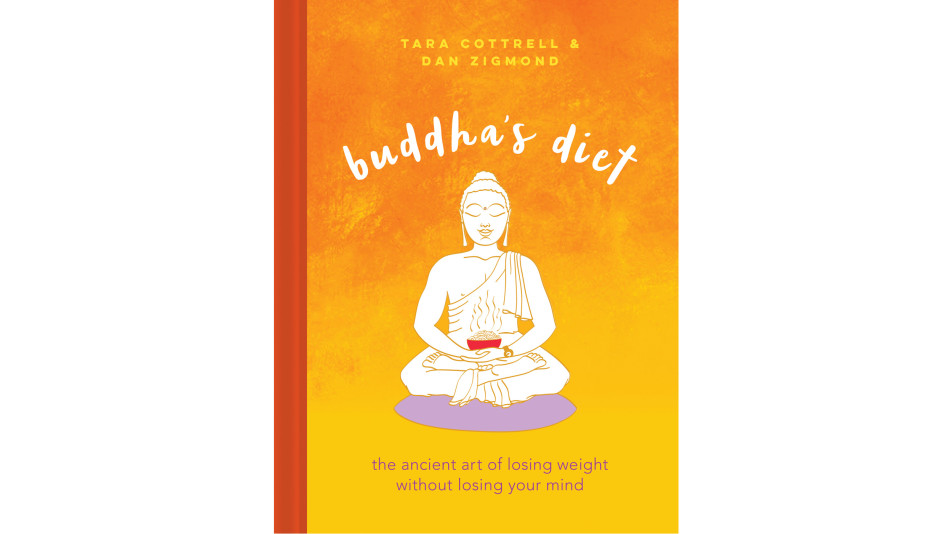The Chart That Could Help You Lose Weight
The authors of Buddha's Diet share how making an easy shift in eating habits can lead to big changes in how you look and feel.

Photo: Foxys_forest_manufacture/istockphoto
Round-the-clock eating in the mindless style many of us consider normal, is not normal at all. Unfortunately in many parts of the world—and the United States in particular—cheap, easily accessible and poor quality food is ready and waiting for us 24/7. This diagram illustrates the unfortunate, modern norm for eating in this country, with meals and snacks consumed throughout the day:

Illustration: Kena Ravel
In looking at this diagram you may be thinking: That's ridiculous, I don't eat for 16 hours! Really? Think about it. Remember, everything counts. Just because you aren't having a meal, doesn't mean you aren't eating. Do you have a snack while watching TV before bed? Do you finish your glass of wine an hour before you turn in for the night? All that counts. Now that you notice your current eating clock is way too generous, it's time to move to start dialing it back.
THE 12-HOUR WINDOW
The first true step of Buddha's Diet is to confine your eating to 12 hours a day. Don't worry about changing what you eat or how much you eat—just do it all within 12 hours. The most natural schedule for most people is something like 7 a.m. to 7 p.m. or 8 a.m. to 8 p.m., but choose a window that works for you. If you work an early shift, maybe you need to have breakfast at 6 a.m. If you're a late-riser (or a college student), maybe you want to start your eating day at 10:00 a.m. or 10:30 a.m.—but try not to let it get too late. There is some evidence that eating late at night can be problematic, especially when you're trying to lose weight. We don't know exactly why this is, but it may be that the body has a harder time dealing with all those calories when your metabolism is operating out of sync with your circadian rhythm. (This is especially tricky if you have to work a night shift. Recent studies suggest nighttime work and daytime sleep makes weight loss more challenging, in part because the body seems to burn calories differently when you sleep during the day.)
Whatever window you choose, make sure you finish dinner (and eating—so dessert, snacks, everything) within 12 hours from the start of breakfast, as this diagram shows:

Illustration: Kena Ravel
Keep in mind that while we include snacks in the 12-hour window diagram, you don't have to snack. More than likely though, you are snacking during these hours—maybe even a lot. But how many meals and snacks you eat is up to you at this point. We are focused on the when, not the how much or the what. A lot of people don't need to adjust any meal times to make this work, but you do have to stop nighttime nibbling.
One thing you may notice is just how much you used to eat after dinner. In a small study of overweight adults using smartphone apps to track their eating throughout the day, participants ate over a third of their calories after 6 p.m.—and almost all of those were probably unnecessary. As the scientists put it in precise technical terms, "food consumed after 6:36 p.m. exceeded the maintenance calories requirement." Whether it's popcorn while you stream a movie or a cocktail on the couch, you may be surprised by how much you used to consume in the evening. All of this has to stop. (And yes, drinking counts.)
The 12-hour window is easy because many of us don't even need to reschedule any of our real meals—or we need to shift them only very little—to squeeze them into 12 hours. But it's hard because we have to pay attention to when we're eating, and we have to train ourselves to stop, completely, when our time is up. You'll probably find that a lot of what you were eating after dinner was of the empty calories variety, or just plain old junk food. Almost no one whips up a kale salad or a roast when they're craving a snack at 11 p.m.—we grab ice cream or chips or something else easy, processed and often unhealthy. A side benefit of minimizing your eating hours in the evening is you simply won't reach for so much of that stuff anymore. There may be a few nights at first when you can't imagine you'll make it until morning without a snack. But you will.
Soon this will all become second nature. As you progress to the next steps of Buddha's Diet, remember that you are forming new patterns and with them a new eating clock. Your mind will undergo a change as much as your body will. You'll see this in the form of greater discipline, more selective choices and increased mindfulness about eating. When the hours and the things you eat take on increased importance, it quickly becomes easier to move away from the free-for-all foraging of your old life and finally end the all-hours buffet of bad choices.

Adapted with permission from Buddha's Diet © 2016 by Tara Cottrell and Dan Zigmond, Running Press, an imprint of the Perseus Books Group, a Hachette Book Group Company.
Want more stories like this delivered to your inbox? Sign up for the Oprah.com Healthy Body Newsletter!

Illustration: Kena Ravel
In looking at this diagram you may be thinking: That's ridiculous, I don't eat for 16 hours! Really? Think about it. Remember, everything counts. Just because you aren't having a meal, doesn't mean you aren't eating. Do you have a snack while watching TV before bed? Do you finish your glass of wine an hour before you turn in for the night? All that counts. Now that you notice your current eating clock is way too generous, it's time to move to start dialing it back.
THE 12-HOUR WINDOW
The first true step of Buddha's Diet is to confine your eating to 12 hours a day. Don't worry about changing what you eat or how much you eat—just do it all within 12 hours. The most natural schedule for most people is something like 7 a.m. to 7 p.m. or 8 a.m. to 8 p.m., but choose a window that works for you. If you work an early shift, maybe you need to have breakfast at 6 a.m. If you're a late-riser (or a college student), maybe you want to start your eating day at 10:00 a.m. or 10:30 a.m.—but try not to let it get too late. There is some evidence that eating late at night can be problematic, especially when you're trying to lose weight. We don't know exactly why this is, but it may be that the body has a harder time dealing with all those calories when your metabolism is operating out of sync with your circadian rhythm. (This is especially tricky if you have to work a night shift. Recent studies suggest nighttime work and daytime sleep makes weight loss more challenging, in part because the body seems to burn calories differently when you sleep during the day.)
Whatever window you choose, make sure you finish dinner (and eating—so dessert, snacks, everything) within 12 hours from the start of breakfast, as this diagram shows:

Illustration: Kena Ravel
Keep in mind that while we include snacks in the 12-hour window diagram, you don't have to snack. More than likely though, you are snacking during these hours—maybe even a lot. But how many meals and snacks you eat is up to you at this point. We are focused on the when, not the how much or the what. A lot of people don't need to adjust any meal times to make this work, but you do have to stop nighttime nibbling.
One thing you may notice is just how much you used to eat after dinner. In a small study of overweight adults using smartphone apps to track their eating throughout the day, participants ate over a third of their calories after 6 p.m.—and almost all of those were probably unnecessary. As the scientists put it in precise technical terms, "food consumed after 6:36 p.m. exceeded the maintenance calories requirement." Whether it's popcorn while you stream a movie or a cocktail on the couch, you may be surprised by how much you used to consume in the evening. All of this has to stop. (And yes, drinking counts.)
The 12-hour window is easy because many of us don't even need to reschedule any of our real meals—or we need to shift them only very little—to squeeze them into 12 hours. But it's hard because we have to pay attention to when we're eating, and we have to train ourselves to stop, completely, when our time is up. You'll probably find that a lot of what you were eating after dinner was of the empty calories variety, or just plain old junk food. Almost no one whips up a kale salad or a roast when they're craving a snack at 11 p.m.—we grab ice cream or chips or something else easy, processed and often unhealthy. A side benefit of minimizing your eating hours in the evening is you simply won't reach for so much of that stuff anymore. There may be a few nights at first when you can't imagine you'll make it until morning without a snack. But you will.
Soon this will all become second nature. As you progress to the next steps of Buddha's Diet, remember that you are forming new patterns and with them a new eating clock. Your mind will undergo a change as much as your body will. You'll see this in the form of greater discipline, more selective choices and increased mindfulness about eating. When the hours and the things you eat take on increased importance, it quickly becomes easier to move away from the free-for-all foraging of your old life and finally end the all-hours buffet of bad choices.

Adapted with permission from Buddha's Diet © 2016 by Tara Cottrell and Dan Zigmond, Running Press, an imprint of the Perseus Books Group, a Hachette Book Group Company.
Want more stories like this delivered to your inbox? Sign up for the Oprah.com Healthy Body Newsletter!



